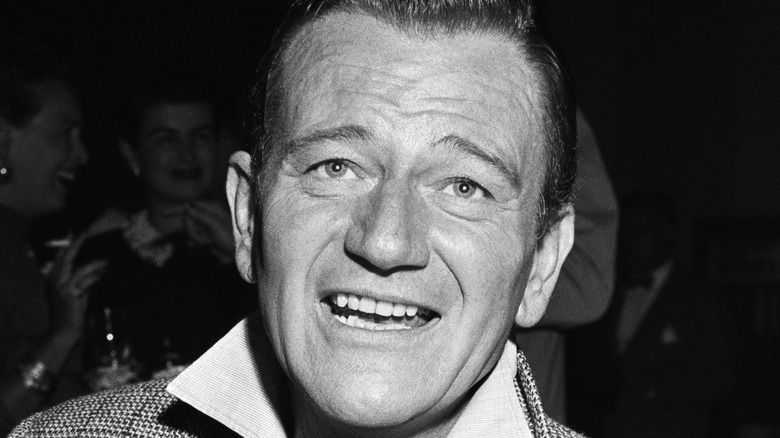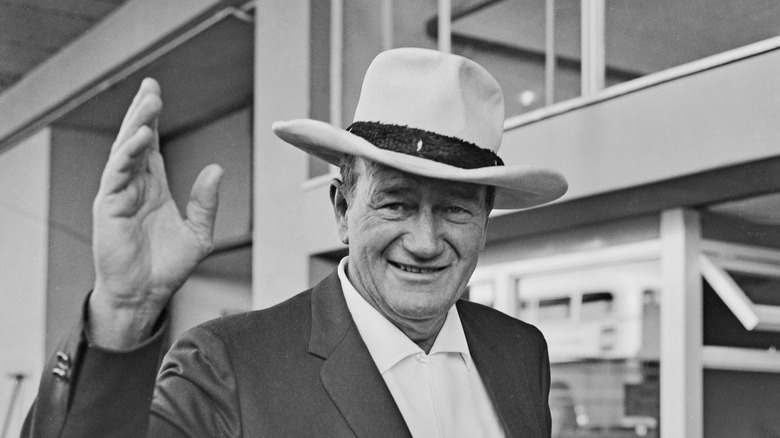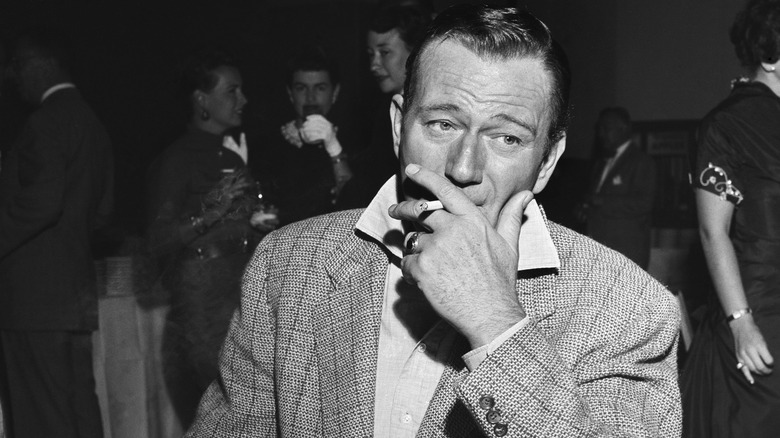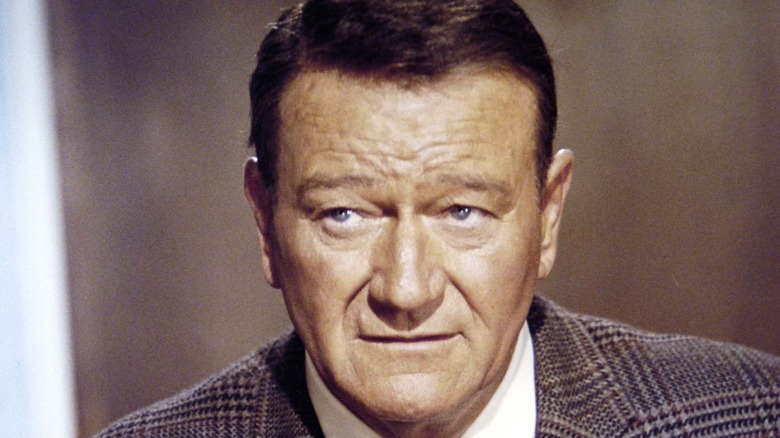Here's Who Inherited John Wayne's Money After He Died
John Wayne was once one of the biggest names in Hollywood. His performances in multiple Westerns even led to his name becoming synonymous with the genre (via Biography). Born as Marion Robert Morrison in Iowa, History writes that his family eventually settled in Glendale, California when he was a child. At the time, Wayne went by "Duke," a nickname that stuck for the rest of his life. In high school, he was known for his natural athleticism and received a football scholarship for the University of Southern California.
However, an injury forced the young Wayne to abandon his sports dreams (per John Wayne). In 1926, his football coach landed him a job at the Fox Film Corporation. Wayne worked as a prop man and eventually, an extra. According to Britannica, he soon struck up a friendship with director John Ford. Ford allowed Wayne to herd geese in his 1928 film "Mother Machree." He later introduced Wayne to another director, Raoul Walsh.
Walsh changed Marrion Morrison's name to "John Wayne" and gave him his first leading role in "The Big Trail." Released in 1930, the western flopped. For the next several years, Wayne starred in low-budget films and spent his time wisely. He honed his craft and created the on-screen persona he is now remembered for. Then in 1939, his old buddy Ford cast him in "Stagecoach" as Ringo Kid. Ultimately, the film revitalized Wayne's career and he spent the next few decades as one of the world's biggest Western stars — and a millionaire.
The making of an American icon
According to Biography, "Stagecoach" was nominated for seven Academy Awards and won two. Most importantly, it introduced audiences to Wayne and his signature rough and tumble guise. After 1939, Britannica writes that he essentially worked non-stop. His next role was in another Ford film, "The Long Voyage Home." Once again, it proved Wayne's acting abilities and his brazen on-screen presence. Based on a play by Eugene O'Neill, the film received several Academy Award nominations. IMDb reports that between 1939 and 1963, Wayne and Ford collaborated on a number of films. As History explains, Wayne, for the most part, always played a similar character.
He personified a typical cowboy that had tenacity and honor. In addition, Wayne starred in various war films including "Sands of Iwo Jima" in 1949. Some of his other notable films include "She Wore a Yellow Ribbon", "Rio Grande," and "The Searchers." In 1969, his role as Rooster Cogburn in "True Grit" won him his first Academy Award (via John Wayne). Unlike his previous roles, Cogburn was not an average clean-cut cowboy.
Off-screen, he was heavily involved in conservative politics. History writes that he eventually merged his beliefs and film together. Wayne later directed and starred in "The Alamo" (1960) and "The Green Berets" (1969). Both films reflected his political views. In 1976, he made his final film "The Shootist," as a gunfighter who is dying of cancer. At the time, Wayne was also battling the disease. He died only three years later.
The film that could have caused John Wayne's death
Throughout his life, Wayne was plagued by cancer. In 1964, Biography writes that he survived lung cancer. It became so aggressive that doctors had to remove one of his lungs and a number of ribs in order to save his life, per The New York Times. Later, he developed stomach cancer, which ultimately killed him on June 11, 1979. According to History, Wayne was 72-years-old at the time of his death.
Though his cancers may have been triggered by Wayne's long history as a smoker, it certainly didn't help that on the set of 1956 film "The Conqueror," he and the rest of the cast and crew worked next to a recent nuclear test site. As Wide Open Country explains, "The Conqueror" was filmed in St George, Utah. Although they were assured it was safe, the area was actually highly radioactive due to winds blowing toxic air from Nevada towards Utah.
Many others who worked on the film also succumbed to cancer in the following years, including director Dick Powell and leading lady Susan Hayward (via Interesting Engineering). In fact, a People article from 1980 reported that out of the 220 people who worked on the film, 91 eventually got cancer, and 46 had died. One of Wayne's final wishes was for his family to use his name to spread awareness of the disease (per the website John Wayne). The John Wayne Cancer Foundation was later created to honor his request and to fund research and more.
Wayne took care of his family and friends, but not his son in law
By the time of John Wayne's death, his film career had made him very wealthy with a net worth of $7 million ($25 million in today's money), per Celebrity Net Worth. Some of his assets included property in Arizona and in Washington State. While he did share his fortune with friends and family, Wayne was very selective in who he left his money to. Per Wide Open Country, he was married three times and had seven children in his lifetime.
John Wayne's will ensured that all seven of his children and his first wife (his second wife died in 1961, per Find-a-Grave) received some compensation, either directly, or through trust funds, leaving them all with five and six-figure sums. He additionally left tens of thousands to both his former and (then) present secretaries, according to CelebAnswers. After Wayne's death, The New York Times reported that his current yet estranged third wife, Pilar Pallete, was excluded from his will. While that was true, Pallete and Wayne already had a financial separation agreement.
It's unknown who received his various properties. However, some of his art and artifacts went to different organizations. One person was barred from receiving any of Wayne's estate — his oldest daughter's husband, Donald LaCava. Not only was LaCava left out of the will on purpose, but Wayne's instructions stipulated that he was to never inherit her share were she to die before him, according to Outside's reporting.



